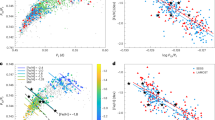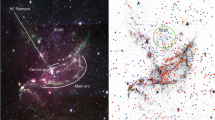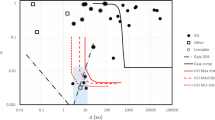Abstract
Very little is known about the physical properties of Kuiper-belt objects1, due to their relatively small size and large distance from the Earth. For example, a Kuiper-belt object with a diameter of 300 km at a typical distance of ∼30 AUwould subtend an angle of only 0.014 arcsec. It is therefore possible to investigate their surface markings, shapes and rotational properties only through variations in the light that they reflect (their light curves). Here we report a survey of optical light curves from Kuiper-belt objects. Variations are observed only for the faintest objects in the survey. We can rule out eclipsing binary objects and variations in the surface markings as the origin of these light curves, suggesting that the observed variations are due to the rotation of irregularly shaped objects. Irregular shapes may be limited to the smallest Kuiper-belt objects because the material strength in their inner regions is sufficient to maintain the shape against the weight of the overlying material. If, however, all of the objects in our survey are of essentially the same size, then the intrinsically faintest ones may be composed of a stronger and darker material than the brighter ones.
This is a preview of subscription content, access via your institution
Access options
Subscribe to this journal
Receive 51 print issues and online access
$199.00 per year
only $3.90 per issue
Buy this article
- Purchase on Springer Link
- Instant access to full article PDF
Prices may be subject to local taxes which are calculated during checkout


Similar content being viewed by others
References
Levison, H. F. & Weissman, P. R. in The Encyclopedia of the Solar System (eds Weisman, P. R., McFadden, L. A. & Johnson, T.) 557–582 (Academic, New York, 1999).
Bowell, E. B. et al. in Asteroids II (eds Binzel, R., Gehrels, T. & Matthews, M.) 524–556 (Univ. Arizona Press, Tucson, 1989).
Romanishin, W., Tegler, S. C., Levine, J. & Butler, N. BVR photometry of centaur objects 1995 GO, 1993 HA2, and 5145 Pholus. Astron. J. 113, 1893–1898 (1997).
Tegler, SC. & Romanishin, W. Two distinct populations of Kuiper belt objects. Nature 392, 49–51 (1998).
Tegler, S. C. & Romanishin, W. The extraordinary colors of 1994 TB and 1993 SC. Icarus 126, 212–217 (1997).
Tegler, S. C. et al. Photometry of the trans-neptunian object 1993 SC. Astron. J. 114, 1230–1233 (1997).
Hintzen, P., Romanishin, W. & Valdes, F. Galaxies clustering around QSOs with z = 0.9–1.5 and the origin of blue field galaxies. Astrophys. J. 366, 7–15 (1991).
Trentham, N. The luminosity function of dwarf galaxies in four spiral-rich clusters. Mon. Not. R. Astron. Soc. 286, 133–157 (1997).
Jewitt, D. & Luu, J. Optical-infrared spectral diversity in the Kuiper belt. Astron. J. 115, 1667–1670 (1998).
Buie, M. W. & Bus, S. J. Physical observations of 5145 Pholus. Icarus 100, 288–294 (1992).
Davies, J. K., McBride, N., Ellison, S. L., Green, S. F. & Ballantyne, D. R. Visible and infrared photometry of six centaurs. Icarus 134, 213–227 (1998).
Schleicher, D. G. et al. Periodic variations in the activitiy of Comet P/Halley during the 1985/1986 apparition. Astron. J. 100, 896–912 (1990).
Binzel, R., Farinella, P., Zappala, V. & Cellino, A. in Asteroids II (eds Binzel, R., Gehrels, T. & Matthews, M.) 416–441 (Univ. Arizona Press, Tucson, 1989).
Hobbs, P. V. Ice Physics (Clarendon, Oxford, 1974).
Asphaug, E. et al. Mechanical and geological effects of impact cratering on Ida. Icarus 120, 158–184 (1996).
Stern, S. A. Collisional time scales in the Kuiper disk and their implications. Astron. J. 110, 856–868 (1995).
Farinella, P. & Davis, D. R. Short-period comets: primordial bodies or collisional fragments? Science 273, 938–941 (1996).
Stern, S. A. Signatures of collisions in the Kuiper disk. Astron. Astrophys. 310, 999–1010 (1996).
Jewitt, D. C. & Luu, J. X. ACCD protrait of comet P/Tempel 2. Astron. J. 97, 1766–1790 (1989).
Luu, J. X. & Jewitt, D. C. The nucleus of comet P/Encke. Icarus 86, 69–81 (1990).
Brown, W. R. & Luu, J. X. CCD photometry of the Centaur 1995 GO. Icarus 126, 218–224 (1997).
Acknowledgements
We thank D. Schleicher for application of his phase dispersion minimization and phasing software to the KBO lightcurves, and E. Asphaug and J. Davies for comments on the manuscript. We also thank the Steward Observatory Telescope Allocation Committee for telescope time. This work was supported by the NASA Origins of Solar Systems and Planetary Astronomy programs.
Author information
Authors and Affiliations
Corresponding author
Rights and permissions
About this article
Cite this article
Romanishin, W., Tegler, S. Rotation rates of Kuiper-belt objects from their light curves. Nature 398, 129–132 (1999). https://doi.org/10.1038/18168
Received:
Accepted:
Issue Date:
DOI: https://doi.org/10.1038/18168
Comments
By submitting a comment you agree to abide by our Terms and Community Guidelines. If you find something abusive or that does not comply with our terms or guidelines please flag it as inappropriate.



